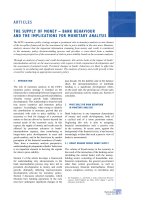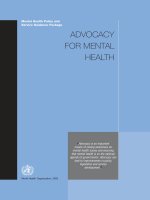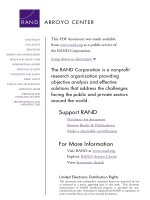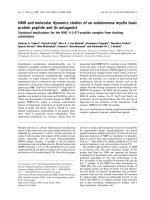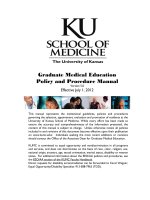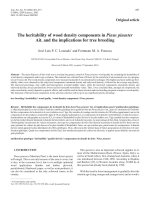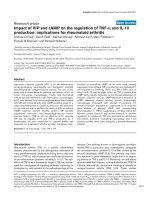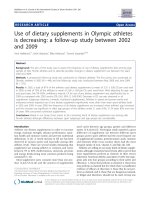the virtual jirga the 2009 education policy and the medium of instruction debate in pakistan who is participating and what are the implications for balochistan
Bạn đang xem bản rút gọn của tài liệu. Xem và tải ngay bản đầy đủ của tài liệu tại đây (2.62 MB, 286 trang )
Ashraf, Muhammad (2014) The virtual Jirga: the 2009 education policy
and the medium of instruction debate in Pakistan__who is participating
and what are the implications for Balochistan? PhD thesis.
/>
Copyright and moral rights for this thesis are retained by the author
A copy can be downloaded for personal non-commercial research or
study, without prior permission or charge
This thesis cannot be reproduced or quoted extensively from without first
obtaining permission in writing from the Author
The content must not be changed in any way or sold commercially in any
format or medium without the formal permission of the Author
When referring to this work, full bibliographic details including the
author, title, awarding institution and date of the thesis must be given.
Glasgow Theses Service
/>
The Virtual Jirga: The 2009 Education Policy and the Medium
of Instruction Debate in Pakistan__ Who is Participating and
What Are the Implications for Balochistan?
Muhammad Ashraf
B.S., M.A. (Hons)
Submitted in fulfilment of the requirements for the degree of
Doctor of Philosophy
School of Education
College of Social Sciences
University of Glasgow
September 2014
Abstract
Since the independence of Pakistan in 1947 almost every education policy was accompanied by the key
question of, “Which language do we choose for instruction and why?” In 2009, after lengthy discussions
commencing in 2005, the Government of Pakistan enacted a new National Education Policy (NEP), which
proposed that the issue of the medium of instruction (MoI) would be addressed by the federal government with
the help of provinces. As soon as the NEP came into force, a strong debate in public and social media began
among teachers, students, politicians, educationists, linguists, and journalists, among others, regarding the
implications of the policy and its statements. This research explores the debate on NEP 2009 with regards to
MoI through views expressed publicly through digital media in the course of a one-year snap-shot. The study
aims to contextualise the participants of the debate and their views in terms of the implications of the NEP
policy for MoI in Balochistan Province, the least literate, ethnically marginalised area of Pakistan, which
harbours one of the most confrontational separatist movements in recent times. The thesis explores the extent
to which the concept of the Jirga, the traditional forum for managing conflicts in the region by engaging in
public negotiations and discussions , to solve issues within the community could be applied in the context of
participation in debate conducted on-line as a ‘virtual Jirga’ .
The research is exploratory and hypothesis generating in nature and a documentary analysis strategy was used
to explore contributions to public debate of the impact of NEP on MoI within one year via the Internet. 37
texts were collected and analysed using Wordle and Wordsmith computer software to find frequently used
words in the dialogue, identify themes and examine the rhetorical forms in which they were expressed. The
corpus of 46,316 words proved to be a rich source for gaining insight into what was being said, by whom and
where thus enabling tendencies in the association of issues such as ethnicity, class, regionalism, class and
educational background to be mapped. The impressions from this snapshot were subject to further examination
in the light of the review of literature and perspectives from Critical Policy Sociology theory and Social
Constructionism were employed. The resulting conceptual framework, drawn from linguistics and policy study
and referencing traditional forms of debating controversial issues, was found to be a useful means of inquiry
at a ‘distance’ as whilst not directly involving the participants their voices can be ‘heard’. What was in part a
pragmatic decision given the situation of the researcher also had the benefit of working with a medium
conducive to reflection on contributions less reactive than might otherwise be the case where debate on the
question of MoI can often shed more heat than light. Digital technology and the internet are part of a rapidly
growing trend of use in academia for communication and as research tools; this thesis combines the use of such
tools with a study of their use and as such contributes to a growing body of scholarship. As with any tool,
however, there are limitations as well as affordances, the researcher recognises that the findings cannot be
generalised and the use of other data collection methods, such as interviews, or a larger sample of texts gathered
over a longer time-scale could lead to different conclusions. However, every effort has been made to make the
process of the planning, conduct and analysis of the research transparent and open to critique as is set out
through the use of the metaphor of uncovering layers in an onion. .
The identification of themes including the English as MoI supporters tendency to favour neo-liberal views on
education, , the Urdu as MoI supporters having a propensity to Islamism, the mother- tongue supporters
inclining towards regionalism and those in favour of the uniform MoI having a partiality to a uniform singletier education system offer confirmation of trends identified in existing research. The analysis of the corpus
also indicates a degree of tension as participants want to promote quality education for the progress of the
country based on research- based policy but are suspicions of the motives of other groups who might be on the
‘winning side’. In summary, the findings suggested that participants in the debate from all groups were positive
about the importance and promotion of quality education in the country, but have reservations on the education
system as being divisive and unproductive. The study concludes that the internet could offer a way forward
by supporting a style of debate based on the Jirga, a Virtual Jirga, stress the referred language, i.e. English, and
contributes to knowledge creation by proposing that the traditional philosophies of Pakistan can be revisited
and some ideal within those practices used to move towards a harmonious society.
II
Table of Contents
Abstract ..........................................................................................................................................II
List of Tables ............................................................................................................................... VI
List of Figures ............................................................................................................................ VII
Dedication ................................................................................................................................. VIII
Author’s Declaration ................................................................................................................ IX
Acknowledgements .................................................................................................................... X
Chapter 1 – Introduction ....................................................................................................... 12
1.1
Background to the Problem .................................................................................... 12
1.2
The Jirga: Concept and History .............................................................................. 16
1.3
1.4
1.3.1
1.3.2
Public Media ..................................................................................................................................... 19
Social Media...................................................................................................................................... 21
Media as a Virtual Jirga ............................................................................................. 18
Personal Experience .................................................................................................. 22
1.5
My Interest in MoI ....................................................................................................... 24
1.6
Research Aims and Objectives ................................................................................ 27
1.7
Rationale of the Study................................................................................................ 28
1.8
Research Questions .................................................................................................... 30
1.9
Structure of the Thesis .............................................................................................. 30
Chapter 2 – Literature Review: Education in Pakistan: Access, Provision and
NEP 2009 ..................................................................................................................................... 32
2.1
Introduction .................................................................................................................. 32
2.2
General Presentation of Pakistan .................................................................................. 33
2.2.1 Population and Geography ......................................................................................................... 33
2.2.2 Linguistic Background of Pakistan ......................................................................................... 34
2.3
Access to Education in Pakistan...................................................................................... 39
2.3.1 Provision of education ................................................................................................................. 39
2.3.1.1
2.3.1.2
2.3.1.3
Public Education .................................................................................................................................... 39
Private Education .................................................................................................................................. 40
Madrassa Education ............................................................................................................................. 40
2.3.2 Availability of Teachers ............................................................................................................... 41
2.3.3 Financing and Expenditure ........................................................................................................ 42
2.3.4 Quality of Schools ........................................................................................................................... 43
2.4
Administration ...................................................................................................................... 45
2.5
The Social Importance of Education in Pakistan ...................................................... 47
2.5.1 Significance of Literacy Rate ..................................................................................................... 48
2.6
The Balochistan Case .......................................................................................................... 50
2.6.1 Geography ......................................................................................................................................... 50
2.6.2 Population ......................................................................................................................................... 51
2.6.3 Linguistic Profile of Balochistan in Society and Schools................................................ 52
2.7
Education Provision in Balochistan .............................................................................. 54
2.7.1 Enrolment Rate ............................................................................................................................... 54
2.7.2 Student Teacher Ratio.................................................................................................................. 55
2.7.3 Quality of Schools ........................................................................................................................... 55
2.7.4 Training and Distribution of Teachers .................................................................................. 56
2.7.5 Public Expenditure ........................................................................................................................ 57
III
2.7.6 Significantly Low Literacy .......................................................................................................... 58
2.8
Education Policy Making Process: An Overview ....................................................... 59
2.8.1 Definition ........................................................................................................................................... 59
2.8.2 Public Demand and Interest Groups ...................................................................................... 60
2.8.3 Participation in Policy Making.................................................................................................. 61
2.9
Contemporary Issues .......................................................................................................... 62
2.9.1 Neo-Liberalism................................................................................................................................ 63
2.9.2 Islamism ............................................................................................................................................. 64
2.9.3 Regionalism ...................................................................................................................................... 64
2.10 National Education Policy of Pakistan 2009 .............................................................. 65
2.10.1
Background ................................................................................................................................. 65
2.10.2
Content .......................................................................................................................................... 67
2.10.2.1
Medium of Instruction (MoI) ............................................................................................................ 67
2.11 Implementation of NEP 2009 in Balochistan ............................................................. 71
2.11.1
Medium of Instruction ............................................................................................................ 71
2.11.1.1
2.11.1.2
2.11.1.3
2.11.1.4
2.11.1.5
2.11.1.6
Comprehensive Language Policy .................................................................................................... 71
Implementation Plan of Action ........................................................................................................ 72
Opportunity to Learn English ........................................................................................................... 73
English, Urdu and Mathematics....................................................................................................... 74
Choice to Select MoI .............................................................................................................................. 74
Mathematics and Science in English after 5 Years .................................................................. 75
2.12 Implications of NEP on Balochistan............................................................................... 76
2.12.1
Teaching and Learning ........................................................................................................... 76
2.12.2
Assessment and Evaluation .................................................................................................. 78
2.12.3
Textbooks..................................................................................................................................... 80
2.12.4
Teacher Training ....................................................................................................................... 81
2.13 Conclusion .............................................................................................................................. 83
Chapter 3 – Research Methodology ................................................................................... 86
3.1 Introduction .................................................................................................................................. 86
3.2
Research Design ................................................................................................................... 86
3.2.1 Research Philosophy .................................................................................................................... 88
3.2.1.1
Method of Analysis ................................................................................................................................ 88
3.2.1.1.1 Policy Sociology ................................................................................................................................ 89
3.2.1.1.2 Social Constructionism .................................................................................................................. 91
3.2.2
3.2.3
Research Approach ....................................................................................................................... 93
Research Strategy .......................................................................................................................... 94
3.2.3.1
Documentary Analysis......................................................................................................................... 94
3.2.4 Time Horizon ................................................................................................................................... 96
3.2.5 Data Collection ................................................................................................................................ 96
3.3 Objectivity ...................................................................................................................................... 98
3.3.1 Researcher’s objectivity .............................................................................................................. 98
3.3.2 Methodological Objectivity ........................................................................................................ 99
3.4
Reliability of the Research Method................................................................................ 99
3.5
Ethical Considerations ..................................................................................................... 100
3.6
Limitations ........................................................................................................................... 101
3.7
Preparation for Analysis ................................................................................................. 102
3.8
Conclusion ............................................................................................................................ 108
Chapter 4 – Data Analysis I: Findings .............................................................................. 110
4.1 Introduction ................................................................................................................................ 110
4.2 Wordle and Wordsmith Data Analysis Software ........................................................... 111
4.3 Wordle Presentation of the Data ......................................................................................... 113
4.4
Wordsmith Appearance of the Data ............................................................................ 116
4.5
Predictable Most Frequent words................................................................................ 117
4.6
Views on Different Types of MoI ................................................................................... 120
4.6.1 Type I: English as MoI ................................................................................................................ 120
4.6.1.1
4.6.1.2
Wordle Image of English as MoI Texts ...................................................................................... 120
Wordsmith Presentation of English as MoI Texts ................................................................ 121
IV
4.6.1.3
4.6.2
4.6.2.1
4.6.2.2
4.6.2.3
4.6.3
Wordle Image of Mother Tongue as MoI Texts ..................................................................... 127
Wordsmith Presentation of Mother Tongue as MoI Texts ............................................... 128
Sample Text ........................................................................................................................................... 129
Type III: Urdu as MoI .................................................................................................................. 133
4.6.3.1
4.6.3.2
4.6.3.3
4.6.4
Text Sample ........................................................................................................................................... 122
Type II: Mother Tongue as MoI .............................................................................................. 127
Wordle Image of Urdu as MoI Texts ........................................................................................... 133
Wordsmith Presentation of Urdu as MoI Texts ..................................................................... 134
Sample Text ........................................................................................................................................... 135
Type IV: Uniform Education System .................................................................................... 139
4.6.4.1
4.6.4.2
4.6.4.3
Wordle Image of Uniform Education Texts ............................................................................. 139
Wordsmith Presentation of Uniform Education Texts....................................................... 140
Sample Text from Uniform Education ....................................................................................... 141
Chapter 5 – Data Analysis II: Emerging Themes .......................................................... 147
5.1 Introduction ................................................................................................................................ 147
5.2
Neo-liberalism in Education Policy Making in Pakistan ...................................... 148
5.2.1 Change and Modernity ............................................................................................................... 150
5.2.2 Job, Market and Economic Prosperity ................................................................................. 156
5.2.3 Internationalisation and Global Identity ............................................................................ 160
5.3
Islamism in Education in Pakistan............................................................................... 163
5.3.1 Islamic Norms and Culture ...................................................................................................... 163
5.3.2 National Identity........................................................................................................................... 169
5.3.3 Social Cohesion ............................................................................................................................. 172
5.4
Mother Tongue as an Agent of Regionalism ............................................................. 174
5.4.1 Regional Identity .......................................................................................................................... 175
5.4.2 Resisting Cultural Promotion.................................................................................................. 178
5.4.3 Local Norms, Values and Traditions .................................................................................... 181
5.5
Uniformity and Education System ............................................................................... 182
5.5.1 Uniformity, Equity ....................................................................................................................... 183
5.5.2 Access ................................................................................................................................................ 184
5.5.3 Overall Progress ........................................................................................................................... 186
5.6
Conclusion ............................................................................................................................ 188
Chapter 6 – Conclusion and Recommendations .......................................................... 190
6.1 Introduction ................................................................................................................................ 190
6.2 Jirga ................................................................................................................................................ 190
6.3 The Social Media as Virtual Jirga ......................................................................................... 192
6.4 Implications for Balochistan ................................................................................................. 194
6.5 Tensions between Traditions and Modernity ................................................................ 203
6.5.1 Suspicion .......................................................................................................................................... 204
6.5.2 Points of Similarities .................................................................................................................... 205
6.6 Limitations................................................................................................................................... 206
6.7 Recommendations .................................................................................................................... 207
6.7.1. To the Federal Government ........................................................................................................... 207
6.7.2 To the Provincial Government.................................................................................................. 208
6.7.3 To Non-state Organisations ...................................................................................................... 209
6.8 Theoretical Contributions...................................................................................................... 210
6.9 Directions for Future Areas of Research .......................................................................... 211
Appendices ............................................................................................................................... 215
List of References ................................................................................................................... 269
V
List of Tables
Table 1.1:
Overview of the news media groups of Pakistan
20
Table 4.1:
Texts and words each MoI type consists of
113
Table 4.2:
Sample of 20 most frequently used words from the text
115
Table 4.3:
Frequently used words in support of English as MoI
121
Table 4.4:
Frequently used words in support of mother tongue as MoI
128
Table 4.5:
List of frequently used words in texts in support of Urdu as MoI
134
Table 4.6:
List of frequently used words in favour of uniform education system 139
Table 4.7:
Summary of participants and their points of view
145
VI
List of Figures
Figure 1.1:
The percentage of users of major languages of Pakistan
13
Figure 1.2:
The Image of a Jirga debating on an issue
17
Figure 2.1:
Map of Pakistan showing provinces and provincial capitals
34
Figure 2.2:
Speakers (in %) of Urdu as mother- tongue and additional
language in different provinces of Pakistan, 2008
Figure 2.3:
37
Speakers (in %) of English as an additional language in different
provinces of Pakistan, 2008
38
Figure 2.4:
Map of province of Balochistan
50
Figure 3.1:
The onion
86
Figure 3.2:
The percentage of the authors in texts
103
Figure 3.3:
Number of the documents with solutions and no solutions
provided for MOI policy
104
Figure 3.4:
Number of print and online media texts
105
Figure 3.5:
Number of male and female authors
106
Figure 4.1:
An illustration of the collected data
113
Figure 4.2:
Wordle image of all texts
114
Figure 4.3:
Wordle image of English as MoI texts
120
Figure 4.4:
Wordle image of mother- tongue as MoI texts
127
Figure 4.5:
Wordle image of Urdu as MoI texts
133
Figure 4.6:
Wordle image of uniform MoI texts
138
Figure 5.1:
The process of how the themes emerged from the data
147
VII
Dedication
To the innocence of my mother and the deprivation of my people: Neither of them could
attend school due to education being used as a battle- field by the opportunists of neoliberalism, Islamism and regionalism.
VIII
Author’s Declaration
I hereby declare that the doctoral thesis entitled, The Virtual Jirga: The 2009 Education
Policy and the Medium of Instruction Debate__ Who is Participating and What Are the
Implications for Balochistan?, is the result of my original and independent research, and that
all sources used have been duly acknowledged. I further declare that this thesis has not been
submitted to this or other university for the same or similar award and nor is it being
concurrently submitted for any other award.
IX
Acknowledgements
In a special way, I would like to extend my sincere thanks and appreciation to Professor
Vivienne Baumfield, my first supervisor, and to Dr. Esther Daborn, my second supervisor,
for giving me all the support that I needed during my studies at the University of Glasgow.
I am grateful to the staff in the School of Education at the University of Glasgow for their
support.
I cannot thank my parents enough who have such great confidence and trust in me. I am
striving to live up to it.
My thanks to all friends in the university and in social life who were always forthcoming to
make my life enjoyable and especially fulfilled (Peter Kopweh, Rasheed Zaheer, Olesya
Nedvetskaya and Gail Goulet).
X
Abbreviations
AEPAM
Academy of Educational Planning and Management
BA
Bachelor of Arts
BEMIS
Balochistan Education Management Information System
BSc
Bachelor of Science
CEDAW
Convention on the Elimination of all forms of Discrimination Against Women
Edu. Pol.
Education Policy
ECE
Early Childhood Education
EFA
Education For All
ESR
Education Sector Reforms
GDP
Gross Domestic Product
GoB
Government of Balochistan
GoP
Government of Pakistan
GSDRC
Government and Social Development Research Centre
HEC
Higher Education Commission
IMF
International Monetary Fund
MA
Master of Arts
MDGs
Millennium Development Goals
MoI
Medium of Instruction
MSc
Master of Science
NEC
National Education Collaborative
NEP
National Education Policy
NGOs
Non Government Organisations
NIPS
National Institute of Population Studies
PEC
Pakistan Education Statistics
PBD
Provincial Budget Documents
PSLSM
Pakistan Social & Living Standard Measurement Survey
UNESCO
United Nations Education Scientific and Cultural Organisation
WTO
World Trade Organisation
XI
Chapter 1 – Introduction
1.1 Background to the Problem
Education plays an important role in the promotion of the ideology, personal development
and economic prosperity of a nation. Soon after the independence of Pakistan in 1947,
Muhammad Ali Jinnah (the first Governor General of Pakistan) announced First Education
Conference (1947), and declared education as the top priority. To achieve this goal a number
of educational institutions were established across the country from 1947 and onward. In the
year 1958, Ayub Khan, an Army General came to power and planned to achieve progress
and modernize the society through public policies. For this purpose as argued by Ansari
(2011), legal and social changes in the policies were introduced. One of the major changes
in the education sector was the introduction of elite private educational institutions, which
according to the government of Pakistan (1959) were established for the promotion of quality
education and economic prosperity of the country. Since then almost each regime reformed
the existing education policies to enable them to deal with the challenges on the ground.
These reforms influenced the enrolment rate, overall literacy level, number of educational
institutions, and facilitation and allocation of budget.
It seems like the importance of education was realised by all regimes, because since
independence, each government came with an education policy aiming at the development
of a state inspired by the ideology of Islam and able to meet the everyday challenges (Govt.
of Pak. 1947; 59; 73; 77; 89; 98; 2009). These policies more or less enhanced the well-being
of the people and the economy of the country but they were accompanied by pressing
challenges which included expanding enrolment in educational institutions, socially- and
economically- based divisive education, poor quality instructions, and an environment not
conducive to teaching and learning. Among these challenges, the Medium of Instruction
(MoI) is one which has received more attention and focus ever-since then. The rationale here
is related to the fact that language is significant for identity, cultural promotion, access to
quality education, the job market and international communication (Whitehead 1995; and
Shamim, 2008).
Fundamentally, Pakistan has five major and 58 minor languages (Rahman, 1997, 2002)
which makes multilingualism a social reality (Siddiqui, 2010; Khalique, 2006) as indicated
12
in Figure 1.1 which shows the major languages spoken in Pakistan and their users
nationwide.
Balochi
4%
Urdu 8%
Others
5%
Siraiki 11%
Sindhi 14%
Punjabi 43%
Pashto 15%
Punjabi
Pashto
Sindhi
Siraiki
Urdu
Balochi
Others
Figure 1.1. The per cent of users of major languages of Pakistan
Source: Pakistan National Census Report, 2001
As it can be noted here, Punjabi, which is the mother tongue of 43% of speakers, is the major
language of Pakistan. The language is mainly spoken by the people living in the East of
Punjab province (Shackle, 1970). Pashto is the mother tongue of the second largest
population (i.e. 15%) in the Khyber Pakhtunkhwa province; and in Southern Balochistan, it
takes second position. Sindhi, which numbers 14% of speakers, is another major language
largely spoken by the majority of the people living in rural areas of Sind province, and stands
in third place. Sariki, spoken by 11% as a mother tongue in the South of Punjab takes the
fourth position, whereas Urdu, the national language of Pakistan is fifth and is spoken as a
mother tongue by only 8% of the total population. It is also the mother tongue of the majority
of the people based in the city of Karachi, in the province of Sind. Finally, Balochi, which
is a major language and the mother tongue of 4%, is spoken by a population largely based
in Balochistan province.
This brief linguistic profile leaves several questions unanswered. For example, why wasn’t
Punjabi selected as MoI? What is the status of these major languages in the NEP 2009 while
selecting MoI? What are the links between MoI and access to education? What is the attitude
of the people towards these languages? Do these languages have any impact as MoI at
13
national and regional level? What positions do these languages occupy in Pakistan and in
the provinces, especially Balochistan? To consider these questions, it is important to know
first of all the linguistic background of Pakistan from a historical perspective (see section
2.1.2).
H e n c e , Pakistan, like many other multilingual nations in the world is faced with an
intricate linguistic situation echoing the colonial experience, religious connections, the
multidimensional socio-linguistic make-up of the population, and the desire to function in
the international market. This complex situation has created genuine linguistic challenges
for teachers, politicians, linguists and policy- makers among others; in a word, all people
who have an interest in language matters in the country. But the relationship between
different languages and their place in education has continuously evolved with the effects
of the religious ideologies, the influence of power structures and socio-political changes.
These processes often posed a threat for access to education, promotion of the regional
languages, solidarity of the Pakistani nation, economic growth and a question mark on the
selection of which language should assume the status MoI.
Basically, the English language has remained an important part of education in Pakistan,
followed by Urdu and regional languages. In 1954, General Ayub Khan established a number
of Army Cadet Colleges and later in 1958 promoted a chain of elite private schools and
colleges around the country. In all such schools English was declared as MoI for the sake of
quality education and to meet the international demands while in the public sector
institutions Urdu was serving as MoI. In the meantime, in some rural schools and madrassas
the mother- tongue of Arabic was the MoI. Due to this varied MoI in range of school types
concerns have been raised on the formation and the reliability of the education policies. For
example, the ethnic nationalists claimed that Urdu as Punjabi muhajir coalition would
endanger the local languages because Urdu is the mother tongue of only 8% people of the
total population, but enjoys the status of MoI and national language while Punjabi, Pashto,
Sindhi are spoken by 15%, 14% and 11% respectively (see figure 2.2 for details) and do not
hold any status. The decision- makers in Pakistan considered English as a ‘global language’
(Crystal, 2003), whereas the Islamists argued that it was a vehicle of the British Empire to
promote Western culture (Haqqani, 2004). Additionally, the Bengalis opposed Urdu as
imperialism by the elites because Bengali was spoken by the majority (Bengali was one
among the major languages and was spoken in the East of Pakistan. East Pakistan acquired
independence in 1971 from Pakistan and became a separate country called Bangladesh).
14
In a way the MoI policies have always seen strong resistance from all those groups whose
language was not chosen for teaching and learning purposes by the state. This resistance is
mainly because of the educational importance of choice of MoI, which helps in accessing
education, child enrolment and securing good jobs (Jahani, 2005; Rahman, 1997; Huizinga,
1994; Abbas, 1993). This makes it clear that MoI in Pakistan is not limited to classroom and
schools only, rather it influences the political, economic, ideological, social and cultural
aspects of the people in the state. This thesis does not include a study of all these aspects,
but rather the impact of National Education Policy (NEP) on them will be elaborated briefly.
This notion has made the issue a serious and debatable one for most of Pakistan’s history.
This is why choice of MoI has always remained of high importance in the making of
education policy.
In 2009, the Pakistan government published a new NEP and a proposed MoI policy after a
lengthy discussion process that started in 2005. The main features of this policy are made up
of statements regarding the development of school language policies and action plans as well
as proposals to create opportunity for children from low economic strata to acquire
education. It also emphasises the use of regional languages and proposes that provinces
should be given choice in selecting MOI. The policy also prescribes the use of English as
MoI in the teaching of Science and Mathematics subjects. The implication here is that the
government has given choice to the provinces, but at the same time imposed English as a
MoI in certain subjects. This is perceived to be a contradiction by many. As soon as the NEP
was announced, a strong debate began in public and social media among different groups
and provinces in the country regarding this and a few other contradictions with the NEP.
Thus, this research explores the current debate on the National Education Policy (NEP) 2009.
To demonstrate, this thesis describes the issue of MoI with reference to the province of
Balochistan. The reasons behind choosing Balochistan as the focal area of this investigation
are multiple. First, this province is where the researcher hails from, and secondly,
Balochistan is the most deprived and lowest in literacy among all provinces (provincial ECE,
2011-15) and thirdly, although the majority of the people speak Balochi and Pashto as their
mother tongue, Urdu is MoI in all public schools. This as Jahani (2005) and Huizinga (1994)
claim is one of the reasons why some ethnic sentiments demand separation from Pakistan.
To undertake a research project of this nature, the thesis sought to cover data from a large
number of views so as to explore participating views in the public debate about MoI. This
entails describing a one- year snapshot, which starts after the announcement date of the
policy. To do this, the study incorporates a range of documentary texts from online media in
15
order to analyse the debate on NEP, 2009 with a special reference to MoI. The texts have
been selected from newspapers, magazines, blogs and social forums. It is certain that other
relevant topics and categories could have been included in the present research, because
to understand the policy debate on medium of instruction in Pakistan in the context of
language policy requires one t o deal wi th a range of other socio- economic categories.
However, due to limited time and space, the thesis has focused on the debate that came
out of the publication of NEP, the important issues within the debate and the impact of the
policy on Balochistan province.
1.2 The Jirga: Concept and History
Historically, conflict and debate over issues has a long history in Pakistani communities.
Similarly those communities have instituted ways of resolving their differences. This way,
in the rural areas, as stated by Taizi (2007) and Wardak (2003), both the conflicts and
resolutions are profoundly linked with the culture of the populace. In Pakistani contexts this
tradition then goes back to the concept of local gatherings famous for Jirga. Jirga is a Pashto
language word which is a century old. It means ‘the gathering of a few’ (Pashto Descriptive
Dictionary, 1978 cited in Wardak, p1272, 2003), and is a form used for managing conflicts
in the rural areas of Pakistan, particularly Balochistan and Khyber Pakhtunkhwa provinces.
The use of Jirga is also prominent practice in Afghanistan (Rafi, 2002; Buchholz, 2007)
particularly in the Pashtun dominated regions. Its prominence in the Pashtun community is
because it is highly accepted tradition (Roashan, 2007; Taizi, 2007; Wardak, 2003; Rafi,
2001). Basically this model is well known for conflict resolution in which issues between
individuals and communities are solved by consensus. In other words this model is a strategic
exchange between people to address an issue through verbal communication. To reach to
this point all the stakeholders needs to take part in the debates and discussions concerning
the matter. The process thus leads the gathering to a certain level of formal communication,
ensuring solution to a problem.
Originally, Jirga is made up of the male members of the community, who sit in a circle,
occupy space at random and speak about problems of great importance. In practice, it is a
body comprised of elderly and influential men of the region for the resolution of disputes
through negotiation. Due to their place and acceptance in the traditions of society, the
political administration does not challenge such a model, but rather uses it for maintaining
justice. See the picture below for illustrations of the Jirga in progress.
16
Figure 1.2. The image of a Jirga debating on an issue
Source: Daily the Nation, 2005
As can be seen in the image such model has no hierarchical position and does not hold any
president, secretary or a convener. The publicly active people or the members of the
conflicting parties sit in the front while the less- active and less visible in public life at the
back. Ordinary people are allowed to listen, but are not allowed to involve themselves in the
discussion. The presence of ordinary people, as Wardak (2003) explains, is to remind the
Jirga members of their presence. This way the decision- making process becomes more
transparent, widely- acceptable and democratic. Thus the elders of the community who are
selected on the basis of their leadership skills or social status or the chief of the area who has
status through their ancestors or sometime through the socio-economic status of a person act
as judges and the participants as jurists.
In terms of the proceedings, the disputant parties present arguments and witnesses. They do
not debate with each other directly; rather, all the parties need to address the members of the
body. This body has the authority to conduct and control the debate without any offence
taken. After hearing all the parties, the members examine the debate and the witnesses to
discover the facts. After inquiries, the members of the body make efforts to find an unbiased
solution to the issues, keeping in mind the traditional, religious, socio–economic, and geopolitical circumstances (Rafi, 2002; Roashan, 2007; Wardak, 2003). Though the practice of
Jirga is not uniform throughout, however, the above description relates to a fairly ideal form
of practice.
17
With the emergence of globalization and the introduction of public and social media the
existence of ‘Jirga’ is considered gender-biased, less-democratic and an old custom which
mainly deals with small issues at local or regional levels.
1.3 Media as a Virtual Jirga
Educated folks and people living in urban areas these days have moved from debating issues
in traditional ways to discussing and debating it on public and social media. It is because
social media has become an agent of awareness used for the solution of social issues to create
a civic forum for debate (Girard, 2012; Hafiz, 2007). This way it became an opportunity for
the excluded groups and as stated in the Government and Social Development Research
Centre (2012), enables people to have their opinions. In the Pakistani context social media
provide a platform for people, including a large number of diverse participants, which might
be as influential as Jirga. The extensive use, recognition and importance of public debates
on media can easily be judged by the example of almost all Pakistani media channels that
have talk shows on daily basis with anchor as the Jirga leader, the guests (mostly from the
political parties explaining their viewpoints) as the conflicting parties while the masses as
the audience. The widespread use of media to present a view can also be judged by one of
the texts from the data ‘give Pashtu official status’, which is commented on (for and against)
102 times by different respondents.
Therefore, it could be suggested that with the far-reaching spread of technology Jirga has
reformed and became ‘Virtual’ where media is playing its role as a judge while the public
are the jurists. This is perhaps because as stated by Hodkinson (2011) the forum of social
media is at the centre of peoples’ everyday lives. It connects people, entertains, and provides
a chance to debate and to allow them to share their views. Media is, therefore, an
opportunity-creator for ordinary persons, which helps in understanding their issues.
Livingston and Lunt (1994) confirm this argument by stating that the enlarging scope of
media and its access is deeply integrated into everyday life and affects our understanding. In
Pakistani contexts too, media plays a vital role, which can be traced as stated by International
Media Support Report (2009) before the separation of the subcontinent. But the media at
that time was not aligned and organised. After the independence of Pakistan, the media
sector has progressed and became enlarged, organised and more nationalist (Mezzera and
Sial, 2010). Noticeably, in recent days Pakistan media is thought the only platform, which
gives voice to the views and issues of common people. Generally in Pakistani contexts media
18
can be divided into public media and social media. A detailed elaboration of the two follows
hereunder.
1.3.1 Public Media
As technology has developed, communication has been based on ‘mass media’, meaning
largely television, radio and the printing press. Although this type of media is a significant
tool used for the transformation of public communication, but it only allows a one-way
message (i.e. from one-to-many). Similarly, public media has a long history in Pakistan;
newspapers especially were the major source of information and awareness during the
independence movement (Mezzera & Sial, 2010). Although the newspapers then were not
as high in circulation and printed in as many languages as they are in the present day, they
were still thought to be the prominent source of propagated information. The public media
under Muslims was used for creating a mind-set so as to prepare the people for a separate
country. This role of media is confirmed by Schlesinger (1991), who sees it as a perceptionsetter. After the independence of Pakistan this cause has turned to a nationalist one and in
the present day to a business-oriented viewpoint (Mezzera & Sial, 2010; Azam, 2008). With
all these alterations public media in Pakistan has become much freer, larger in audience,
wider in scope and a well-known source of mobilisation for people.
Currently, the popularity of public media can be judged by the number of newspapers
published in Pakistan i.e. 142 newspapers, published in 11 different languages and with an
estimated circulation of 4 million copies daily (Mezzera & Sial, 2010). These number reveal
the readership and probably the fact that newspapers are accessible almost in all areas of
Pakistan. Although the range of languages represents a diverse selection, Urdu and Sindhi
language newspapers are the most popular and largely-distributed (Mezzera & Sial, 2010).
According to Azam (2008) and GSDRC (2012) public media is never neutral. That is
probably why the mass media in Pakistan is also divided into three major groups famous for
their diverse ideas, i.e. the Jang group, the Dawn group of newspapers and Nawa-e-Waqt
group.
19
Table 1.1: Overview of the news media groups of Pakistan
Print and
Electronic Media
Dailies
(Newspapers)
Weeklies
(Magazines)
Monthlies
(Magazines)
TV Channels
Jang Group
Daily Jang
Daily Awam
Daily Awaz
The News
Daily Waqt
Pakistan Times
Daily News
Akhbar-e-Jahan
Mag Weekly
The NEWS on Sunday
Jang Sunday Magazine
Geo News
Geo Entertainment
Aag TV
Geo Super
Nawa-i-Waqt Group
Daily Nawa-i-Waqt
The Nation
Nida-i-Millat
Weekly Family
Sunday Plus
Weekly Money Plus
Monthly Phool
Waqt TV
Dawn Group
Daily Dawn
Star
Herald
Aurora
Dawn News
Source: Adopted from Mezzera & Sial (2010)
The Jang group which is thought to be the largest media group tends to have a moderateconservative perspective. The Dawn group of newspapers is considered to be a liberal and
secular institution with moderate views, while Nawa-e-Waqt is famous for its cons ervative
religious thoughts and sees Pakistan as an Islamic state (Mezzera and Sial, 2010;
International Media Support Report, 2009).
Apart from print media, electronic media in Pakistan has also proliferated rapidly in recent
times. There are in total 49 TV channels in Pakistan, i.e. 15 news channels, 32 entertainment
and two religious (Mezzera & Sial, 2010). In another place Michaelsen (2011) explains that
by the end of 2009 the government had issued 70 private TV channel licences. Beside this,
radio is also a vibrant media in Pakistan which according to Mezerra and Sial (2010) has 40
FM stations while Michaelsen (2011) reports that there are more than 100. It is important to
mention that the radio and television channels in regional languages reach people living in
rural areas, using Urdu for the middle class and English for the urban elites (Azam, 2008).
Akin to the other institutions and organisations of Pakistan, public media is also divided
linguistically to appeal to a particular group of people, i.e. those using English, Urdu and
regional languages.
20
Generally English media covers the elites and urban readership. Such newspapers are small
in circulation but have a significant influence (Azam, 2008). They are thought more
professional, less sensational and of a higher quality in terms of selection of the subject
matter (Michaelsen, 2011). They are mostly published in major cities of Pakistan i.e.
Islamabad, Karachi, Lahore, Peshawar and Quetta. English media is more liberal and
democratic compared to its Urdu counterparts and is of great impact among the policy
makers, the politicians and the upper strata of society (Mezerra and Sial, 2010).
The Urdu media on the other hand represents the general public across Pakistan. This media,
famous for its politically sensitive terminologies, has the largest readership (Azam, 2008).
Newspapers in this language are published from almost every district head-quarters (subpart of a province) of all four provinces of the country. They by and large support religious
and conservative views (International Media Support, 2009; Mezerra and Sial, 2010; Rana,
2008).
Finally the media in regional languages is limited to rural areas or a specific region. This is
the least prominent media in Pakistan with smallest readership and circulation. Newspapers
in regional languages are almost representing ethnic groups and their agendas. Apart from
Sindh province, where in urban Sind Urdu is the provincial language while in the rural areas
Sindhi language is the provincial language (International Media Support, 2009; Mezerra and
Sial, 2010).
1.3.2 Social Media
But the arrival of Internet, mobile communication and digital media changed the
communication system in such a way that people can easily network and connect locally and
globally. Therefore social media can be discussed as exclusively modern phenomena
(Curran, 2002), probably because it is backed by modern technology, which is transmitted
to mass audiences and caters to the flow of messages from many-to-many. By contrast in
the traditional Jirga system interactions are only possible face-to-face. Consequently with
the spread of technologies the public sphere has broadened and gradually shifted from
individual and institutional realms to new and completely new ways of communication
(Girard, 2012). In other words, as stated by Castells (2008), it has given independence to
the public by becoming the medium of debate.
21
After the emergence of social media as a debating platform, people are keen to share their
thoughts freely and let the world know of their opinion on a particular issue. This is
probably because people find it easy to debate in this forum because of the lack of fear of
any backlash, and because it is difficult for the state to control. Consequently people come
forward whose voice would otherwise have gone unheard in the absence of this debating
platform (Girard, 2012; Michaelsen, 2011). In recent times the use of social media in
Pakistan has rapidly increased, which according to the B-Solutions findings (2012) is a rise
similar to the one experienced by users in the USA and the UK. Facebook-users have reached
6.4 million in Pakistan to date. Although Jirga is a male-only gathering, the Virtual Jirga
involves both genders, i.e. 69% of the users of social media are male while 31% are female.
When it comes to usage, 72% of people in Pakistan use social media every day and 80% of
people spend more than an hour a day online. Thus the average time of each Pakistani user
on social media is around 40 minutes a day (B-Solutions findings, 2012). It can be confirmed
from the numbers how close media is to people’s lives and public debate.
Also, despite present-day media’s propensity for sleaze, sensationalism and superficiality,
they are still seen as an essential role-player in terms of public debate. One famous example
is the operation in the Sawat region of Khyber Pakhtunkhwa province. Sawat, a small city
became prominent due to the influence of the Taliban in Pakistan. To end the role of the
Taliban, the Pakistan Army has conducted military operation backed by the whole nation.
The unity of the nation and the success of the operation according to Mezzera and Sial (2010)
were because of a campaign on social and public media. They claim such unity was seen for
the first time in the history of the country. Thus the collective voice when raised through
social media makes people wake up to the challenges they are facing (Girard, 2012). There
are several examples of a debate initiated on social media websites, which have been
evident through their ability to increase pressure on governments that are then required to
act tough on the issue at hand, thus bringing into the view of common people. The recent
‘Arab spring’, especially the revolution in Egypt, is one of the most relevant examples
(Howard et al, 2011).
1.4 Personal Experience
My own interest in policy debate on MoI has been influenced by my own background. I was
born in a small and impoverished town in the province of Balochistan and spent my entire
childhood in the rural areas. Formal education in those days especially in rural Balochistan
was not easily accessible due to the few schools available and a lack of teachers. I will also
22
point out that because many parents were uneducated, they did not realise the importance of
educating their children. Some of the boys from my area, including me, went to school in
the morning and in the evening went to madrassa for religious education. After madrassa,
we played football in the street. I clearly recall some of the words that we commonly used
in football i.e., ‘palanty’ (penalty), up up di, (half of the D), ‘up tam’ (half time), ‘andoball’
(hand ball), but we never knew what language they were or what they actually meant.
The school I went to was not fenced. There was no toilet, no school uniform and no morning
assembly. The first thing we did in the morning was to sweep the floor, bring out the
teacher’s chair and go along with some students to bring drinking-water from the nearby
stream. The school timetable started at 9:00am, but the teacher never turned up before
10:00am. It was a grade 1-5 primary school with 30 students in total and only one teacher
who always had a stick in his hand. He handled all 5 classes at a time.
The school had a set of rules. As soon as the teacher walked in, we had to open our books
and start reading aloud. The teacher would sit in his chair and ask each one of us to stand up
and read from the book. The reading was never more than a line. Each of us was chosen in
between to bring tea from home for the teacher, which he would take at break. In the last
part of the day he would always ask us to write on ‘takhti’ a washable wooden object used
for the improvement of writing. I don’t remember if we were given any homework or if our
parents ever asked us about what we did at school.
When I joined secondary school, it was notably bigger and with more teachers than my
primary school. Each subject was allotted a period of 45 minutes. The teacher taught us the
subject’s textbooks including English, which was added as a compulsory subject by the
teacher reading it aloud and instructing us to follow and repeat it. During my time at this
particular school, there were several strikes by teachers demanding their rights. Due to such
strikes the public schools remained closed time to time. Eventually the students were
promoted without exams to the next class. While the school closure was still on, the private
schools were still open and their teachers have never organised any strike action. Thus my
thinking since then has been that there are various types of schools. I have been always
wanted to know the criteria of sending children into different types of institutions. At
university level I realised that the policy has divided the people based on their socioeconomic class. That is how the rich go to private schools, the middle-class to the public
schools, while the poor go to the madrassa. Among friends the debate was often that Pakistan
was formed in the name of ideology, i.e. Islam, and that Islam discourages social classes and
23
believes in equality. But why then do the policies promote the opposite of this? ‘Why was
there not a similar education-type available for all?’ That was my question that had no
answer.
1.5 My Interest in MoI
The language selected as MoI became rapidly important worldwide in recent times, because
it, as argued by Tollefson and Tuli (2004), ‘is the most powerful means of maintaining and
revitalising a language and a culture’ (p2). This can be one of the reasons why in the
countries that remained under colonial domination on the one hand rapidly increase the use
of English, while on the other hand the concerns about the preservation, promotion and
future of the minority and regional languages have grown. Basically choice of MoI is an
enabling tool, which is mainly used in the classroom for teaching and learning purposes. It
on one side plays a role of a facilitator in subject matter and on the other side, a means for
students to express their viewpoint (Kyeyune, 2010). But in a wider perspective it can be
used for multiple purposes, which include religious, economic, social, cultural and political
ones. Although the language selected as MoI is an area of power, at the same time it can be
used for resolving the ethnic conflicts among different groups. Studies of MoI policies in
countries such as Slovenia and South Africa show that choice of MoI is a source of
compromise in areas of ethnic conflict (Webb, 2004; and Tollefson, 2004). These studies
make it evident of how MoI is used as a compromising source among different ethnic groups.
Choice of MoI is an integral part of education policy because it is closely linked to who is
accessing education and how effective that education is. Tollefson (2004) claims there are
hidden agendas behind the selection of MoI, which protect special groups of people. One of
the strong speculations about MoI is its important role used by the various empires to keep
the colonies under their domination. They have done so by establishing a small number of
private English medium schools for the children of a selected number from the locality. This
group was prepared for the role of as the social elites, by creating white-collar jobs for them.
Through such positions they were able to gain high status and the power of decision-making
at the state level. This class, as mentioned by Deng and Gopinathan (2006), acted as the
bridge between the colonizers and the local people. This has been the situation in Asian and
African countries and thus betrayed the struggle against the colonial domination. It is
probably due to this debate that Haye (1987) labelled the MoI as a ‘political football’.
24
